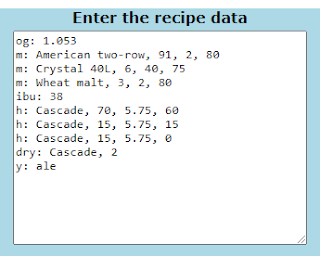The Beer Engine 2024 software was created to power the FlexStyle calculators that create a recipe based on beer styles. Later, it occurred to me that sometimes brewers just want to share a recipe with others without exploring the intricacies of a beer style. Something more compact than FlexStyle would be very practical for sharing purposes.
Communicating brewing recipes is awkward because brewers have differences in equipment and processes. Mash efficiency is a key issue. Commercial breweries that continuous (fly) sparge might have 90% efficiency whereas a brew-in-a-bag homebrewer might get 70% efficiency. Simply reporting the weights in a grain bill can is problematic because of these differences. The 70% brewer will need more grain for the same volume than the 90% brewer. There needs to be a way to easily bridge this gap.
The Beer Engine 2024 - Concise software has the critical recipe variables in a single field. Simple codes are used like m: for malt and h: for hops. The values associated with a variable are separated by commas (i.e., comma separated values) and can be easily edited by the user if desired. Here are two examples.
m: Malt name, fermentable percentage, Lovibond, and yield (SG or percent)
h: Hop name, IBU %, alpha acid %, and boil minutes
Here's an example for a basic American pale ale.
- The American pale ale example shown above, with additional explanations.
- Guinness draft clone with instructions for malt extract variations
- Sierra Nevada Resilience IPA clone with instructions for malt extract versions

No comments:
Post a Comment